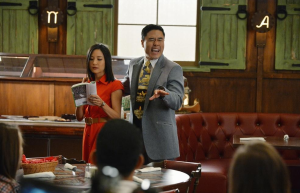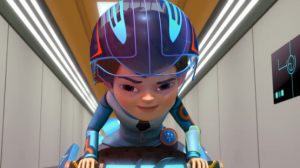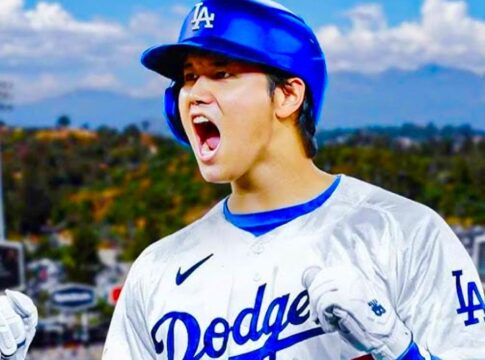(This blog post is reposted from David’s personal blog site with his permission)
“I have always known that moment of disappearance and the even uglier truth is that I have long treasured it. That always honorable-seeming absence. It appears I can go anywhere I wish. Is this my assimilation, so many years in the making? Is this the long-sought sweetness?”
–Chang-rae Lee, Native Speaker
LATEST STORIES
Lost amid the well-deserved fanfare accompanying the premiere of ABC’s new prime-time comedy Fresh Off the Boat was the launch of another major-studio show featuring an Asian American family. Like Eddie Huang’s brainchild, it is a big-budget vehicle as well, with stars such as Olivia Munn, George Takei, Bill Nye, Mark Hamill, and Adrian Grenier lending their talents to its production. However, unless you are like me, a parent or caregiver to a preschool-aged child, you may not know what I’m talking about. Miles from Tomorrowland is an animated series for Disney Junior that made its debut only a few days after that of Fresh Off the Boat. (Disney-ABC owns both station.) In this blog entry I will discuss these new shows, particularly how they represent extant and potential relationships between Asian Americans and other racial groups, particularly white people. What does it mean that traditional and social media have christened Fresh Off the Boat as the “Asian American” show, while the publicity for Miles from Tomorrowland makes no mention of race? The latter is a “postracial” narrative while the former is decidedly “racial” in its intent and reception.
Miles from Tomorrowland chronicles the planet-hopping adventures of a family of four, members of an institution familiar to anyone who has visited the Magic Kingdom–the “Tomorrowland Transit Authority.” The star of the show is Miles Callisto, an intrepid young boy who learns about science while solving problems with his creative use of technology. His mother, Phoebe, is the captain of their spaceship. Father Leo and sister Loretta round out the foursome. With the exception of Leo, who is white, the other Callistos are of Asian descent. To be clear, nothing from the official publicity for Miles from Tomorrowland overtly states that Phoebe is an Asian American. The voice actor for Phoebe is the well-regarded Olivia Munn, whose mother is Chinese. Just to be sure, I contacted the creator of the show, Sascha Paladino. Paladino told me that Miles is Chinese American. Moreover, Paladino revealed, later episodes of the show will explore Miles’ Chinese heritage. Targeted at preschoolers, the show is a developmentally-appropriate multicultural narrative: the star is a mixed-race boy who maintains a connection to his ethnic identity, and the Asian American characters do not exhibit any stereotypical behaviors. It promises to honor cultural diversity while understanding it as no barrier to social potential. My mixed-race son loves it, and I’m glad that there is once again an animated protagonist who shares his heritage.
This blog entry compares Miles from Tomorrowland with Fresh Off the Boat to illustrate a core concept of antiracist education that still generates much confusion, the difference between ethnicity and race. These terms are often used interchangeably, without much precision, at almost every level of discourse. Like most modern children’s programming, Miles from Tomorrowland is not interested in exploring the meaning of the Callistos’ racial identity, as doing so would entail representing how their social station–where they live, what the parents do for a living, where the children go to school, etc.–is related to the value assigned to the color of their skin. Rather, to the extent that the show finds meaning in Miles’ diversity, that meaning will be located in his ethnicity–the language that he speaks, the holidays he celebrates, the food that he eats. However different Miles is from other people in his life, those differences will say nothing about the relative power each of them has in society; this is because young children don’t need to know about the world in that way yet. (Sadly, this innocence dissipates more quickly for some than others.) This isn’t to say that Miles from Tomorrowland doesn’t signify in unintended ways–impacts I will address later–only that its handling of racial alterity is age-appropriate. When you are four or five-years-old and see and honor differences in others as non-hierarchical cultural differences, you are right where you need to be.
Fresh Off the Boat also features young Asian American siblings, the oldest of whom is the ostensible star of the show, Eddie. Like the childhood of the show’s creator, Fresh Off the Boat is set in a mid-1990s, predominantly-white community, the domain of gangster rap and Lunchables, we discover. As the eldest child, eleven-year-old Eddie is just now beginning to gain awareness of his racial identity as an Asian American. Racialized diversity in the world of Fresh Off the Boat is different from the cultural diversity of Miles from Tomorrowland in how it becomes a source of tension after it runs headlong into white supremacy culture. Eddie’s teacher is relieved when she doesn’t have to say a Chinese name; Cattleman’s Ranch restaurant needs a white host to attract white customers; Eddie’s homemade Chinese noodles humiliate him among the cafeteria crowd. The Huangs are racialized in Fresh Off the Boat, as they should be in any production whose primary audience is, well, adults. Their social power has everything to do with the dominant meanings of “Asian,” which include the stereotypes of the “perpetual foreigner” and the “model minority.” Additionally, the show reveals how even Chinese culture is unstable. Early observers have focused on Eddie’s adoption of hip-hop culture as an oppositional stance, but less-overt practices, such as his flaunting of his pizza Lunchables, reveal how Chinese culture transitions into Chinese American culture–culture that is aware of and responsive to white supremacy.
Fresh Off the Boat’s decision to foreground the Huangs’ racial identity over their ethnic identity explains the generally-positive responses  from Asian American viewers. On the whole, Asian Americans’ collective sigh of relief after viewing the first few minutes of the show turned into a deep cheer after it became apparent that it was not interested in pandering to racist audience expectations. White viewers tended to be supportive as well, although a Facebook group was created to log unfavorable responses to the show from white people. Some of these posts objected to the portrayal of white people, but others seemed to want to advocate for Asian Americans by calling out the show’s stereotypes of them. There are a few familiar stereotypes in the narrative, but it’s worth remembering what Chimamanda Adichie said about stereotypes in her TED Talk, “The Danger of a Single Story.” “The problem with stereotypes is not that they are untrue,” Chimamanda says, “but that they are incomplete. They make one story become the only story.” Fresh Off the Boat can sweat a stereotype here or there because it offers so many other stories of what it means to be an Asian American family, many of them encounters with racism and white supremacy. Like Miles from Tomorrowland, it is developmentally-appropriate for its age group, regardless of race.
from Asian American viewers. On the whole, Asian Americans’ collective sigh of relief after viewing the first few minutes of the show turned into a deep cheer after it became apparent that it was not interested in pandering to racist audience expectations. White viewers tended to be supportive as well, although a Facebook group was created to log unfavorable responses to the show from white people. Some of these posts objected to the portrayal of white people, but others seemed to want to advocate for Asian Americans by calling out the show’s stereotypes of them. There are a few familiar stereotypes in the narrative, but it’s worth remembering what Chimamanda Adichie said about stereotypes in her TED Talk, “The Danger of a Single Story.” “The problem with stereotypes is not that they are untrue,” Chimamanda says, “but that they are incomplete. They make one story become the only story.” Fresh Off the Boat can sweat a stereotype here or there because it offers so many other stories of what it means to be an Asian American family, many of them encounters with racism and white supremacy. Like Miles from Tomorrowland, it is developmentally-appropriate for its age group, regardless of race.
The danger of popular multicultural texts such as Fresh Off the Boat eschewing racism as a part of life is the perpetuation of ethnicity as the only story of what is “diverse” about non-white people . When I teach Asian American literature to my students, I explain that each text says what it “means” to be Asian or Asian American, whether its author intended it to or not. How does a TV show signify what it “means” to be a Chinese American kid then? It can mean that you call your grandmother Nai Nai or that you get little red envelopes full of cash on Chinese New Year’s. Or it can mean that your black classmate calls you “Chink” (a powerful moment in the pilot) or your middle school teacher doesn’t think you’re any good at the language arts. Being the target of racism is also part of what it means to be “diverse.” I suspect that those viewers who are offended by portrayals of white people have a problem with talking about racism in general. Their desire is for a show to represent the possible relationships between white people and Asian Americans without the mediating tension of white supremacy. For them, I can recommend a fine work of science-fiction, Miles from Tomorrowland.
Miles from Tomorrowland avoids potential controversy because the Callistos live in the future, off Earth, a setting that obviates any role for racial identity. As imagined by the show, the future is as notable for the absence of race as for the ubiquity of whiz-bang technology. Venerable is the hope that racism will eventually burn itself out, unable to sustain itself amid unstable phenotypes brought about by mixed-race marriage and its issue. In 1909, the writer Sui Sin Far, born Edith Eaton to a Chinese mother and English father, published Leaves from the Mental Portfolio of an Eurasian, an autobiographical essay questioning the social meanings of her ancestry:
Fundamentally, I muse, people are all the same. My mother’s race is as prejudiced as my father’s. Only when the whole world becomes as one family will human beings be able to see clearly and hear distinctly. I believe that some day a great part of the world will be Eurasian. I cheer myself with the thought that I am but a pioneer. A pioneer should glory in suffering.
Sui Sin Far, recognized by scholars as the first Asian American fiction writer, understood the problem of racism as a problem of perception. Sui Sin Far may not have envisioned the future as otherworldly, but a terrestrial society dominated by mixed-race people would have struck her as no less remarkable. For Sui Sin Far, if perceptions of Chinese and mixed-race people were ever going to improve, the transformation would have to begin with the body–because institutional change was a lost cause. But attempting to procreate or adopt racism out of existence won’t necessarily transform any of the structures that maintain white supremacy and may even support them, especially in the case of Asian Americans.
In the Fresh Off the Boat pilot, Eddie’s mother, Jessica, somehow allows herself to be conscripted by a neighborhood gang of rollerblading mothers. The joke is that all of these white women look alike to Jessica. “Are you all sisters?” she asks them. (Jessica’s posse still one-ups Disney-ABC’s Fresh Off the Boat blogger party that failed to invite any Asian American bloggers.) It’s true that the white characters don’t have much more than a single story so far. But they are in no danger of being negatively stereotyped, stereotypes existing only to justify the place of a group within society. Plus, it’s nice to see the Huangs have so many stories that speak of their status as non-white people, including Jessica’s “tiger mom” approach to learning, sure, but also her threat to sue Eddie’s school for its lack of a proper response to hate speech. Unlike the Callistos, the Huangs are racialized because they are a part of our world, albeit twenty years ago. For Jessica and Louis, who are immigrants, whiteness is cowboy suits and dog waste bags, necessary masquerades that may help get you a “nut” but never threaten who you know yourself to be. For the kids, who grow up in America, the negotiation is trickier. They are apt to believe the story of whiteness and so hope to merge into it. Groups like Edward Blum’s The Project on Fair Representation want to write Asian Americans into that story by conscripting them to join white people in its fight against affirmative action. In ignoring the impacts of institutional racism, The Project on Fair Representation already believes that we live in Tomorrowland. I’m just thankful that Jessica and Louis Huang know that a school needs to get its ass sued off for an entirely different reason.
(David Shih is an associate professor of English at the University of Wisconsin-Eau Claire).








